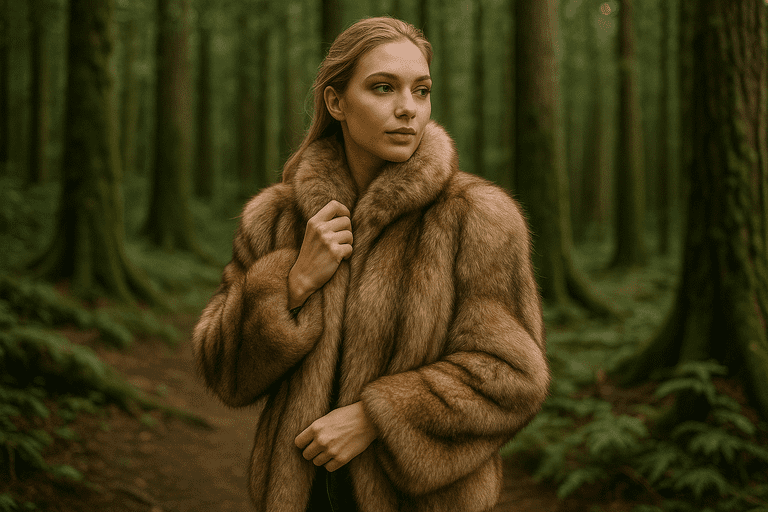Choosing when to wear fur goes beyond fashion—it involves weather conditions, social settings, and ethical considerations. Fur garments offer exceptional warmth, making them ideal for cold climates and winter seasons. Therefore, most people consider wearing fur coats or accessories in late fall through early spring.
In addition, the texture and weight of fur matter. Mink, fox, or rabbit fur varies in thickness, which determines its suitability for certain temperatures. For instance, heavy furs are perfect for snowy environments, while lighter furs may work better for crisp but mild days.
Moreover, understanding fabric combinations can guide your decision. Mixing fur with cashmere or wool creates stylish yet practical looks. However, timing is key—wearing fur too early or too late in the season may feel out of place or uncomfortable.
By learning how temperature, texture, and timing align, you’ll make smarter choices about when to wear fur without compromising comfort or style.
Seasonal Style Guidelines
While fur offers timeless elegance, knowing when to wear fur by season helps you stay fashionable and appropriate. During winter, fur becomes both a functional and aesthetic asset. Whether you’re attending a formal holiday event or taking a brisk walk in the snow, fur coats and trims offer sophistication and warmth.
For instance, December and January are ideal months for full-length fur coats. The cold air justifies heavier garments, and seasonal trends often embrace rich textures. In contrast, early autumn or late spring calls for lighter options like fur vests, capes, or stoles. Therefore, adjust your fur choices according to seasonal shifts.
How Do I Wear A Shawl for Any Occasion
In addition, consider your regional climate. Someone living in Northern Europe may get more use out of fur compared to someone in Southern California. Local weather influences not just temperature but also public perception of fur wear.
Staying aligned with the season ensures your fur wardrobe feels relevant, intentional, and comfortable throughout the year.

Matching Fur with Occasions
Aside from weather, understanding when to wear fur depends heavily on the occasion. Formal events like gala dinners, theater performances, and black-tie parties are perfect opportunities for showcasing luxurious fur pieces. These settings elevate the garment’s appeal and suit its regal presence.
In addition, winter weddings or upscale evening events may call for fur accents—like shawls or collars—to complement gowns or tailored suits. For instance, a fur stole can add a touch of glamour to a minimalistic dress without overwhelming it. Therefore, fur becomes more than a warmth layer; it becomes a fashion statement.
However, casual or business environments may require moderation. Wearing fur-lined accessories like gloves or hats can introduce the element subtly. Timing and tone of the occasion determine whether fur should be the centerpiece or just an elegant accent.
By matching fur to the event, you ensure it complements rather than overshadows your look, maintaining balance and elegance.
Pairing Fur with Modern Fashion
Fur can be timeless, but its modern styling makes it versatile for today’s fashion landscape. Learning when to wear fur with current trends helps you stay on point while respecting tradition. Pairing fur with jeans, leather boots, or sleek turtlenecks creates a chic, contemporary outfit.
In addition, streetwear and high fashion often blend elements like faux fur with edgy silhouettes. For instance, cropped fur jackets paired with wide-leg pants have become a popular look during fashion week in colder cities. Therefore, mixing fur into casual wear is entirely possible.
When to Wear Flannel for Ultimate Comfort
Moreover, accessories play a huge role. Fur bags, keychains, and trims offer subtle luxury without feeling outdated. Knowing how to integrate fur into your modern wardrobe gives you more options and greater style flexibility.
By combining classic materials with today’s cuts and fabrics, you’ll know exactly when to wear fur without sacrificing your fashion-forward edge.

Ethical Considerations: When To Wear Fur Responsibly
In recent years, the fashion industry has seen growing awareness around sustainability and ethics. Understanding when to wear fur responsibly requires you to stay informed about sourcing and production. For instance, opting for vintage or upcycled fur minimizes environmental impact and supports circular fashion.
In addition, many brands now offer ethically sourced fur or certified farm-raised alternatives. This transparency allows consumers to make informed choices. Therefore, if you care about animal welfare and sustainability, you can still enjoy the elegance of fur without compromising your values.
How to Wear a Skirt to School and Feel Confident
Moreover, faux fur continues to improve in texture and realism, making it a viable option for many. Pairing ethical choices with seasonal appropriateness allows you to enjoy the look and feel of fur while honoring conscious consumption.
Ultimately, responsibility and style can coexist—so long as you know where your garments come from and choose when to wear fur with intention.
When To Wear Fur: Climate and Regional Considerations
Your location plays a critical role in deciding when to wear fur. In colder regions like Canada, Scandinavia, or parts of Russia, the practicality of fur outweighs any debate. Harsh winters with sub-zero temperatures make fur coats not just fashionable, but necessary for warmth and comfort.
For instance, in these areas, fur might be worn daily during the colder months. However, in milder climates such as coastal California or the Mediterranean, fur is more of a fashion accent than a daily essential. Therefore, wearing fur in such regions is typically reserved for specific evenings or indoor events.
In addition, some regions may have cultural associations with fur, influencing when and how it is worn. Understanding local norms ensures that your style remains both respectful and appropriate. A fur coat might be celebrated in one area and criticized in another.
Being aware of regional expectations helps you decide not only what to wear, but when to wear fur with confidence and cultural sensitivity.

When To Wear Fur: Faux Fur as a Seasonal Alternative
With sustainability becoming a focal point in fashion, faux fur has emerged as a stylish and ethical alternative. Knowing when to wear fur made from synthetic fibers depends largely on temperature and occasion. Faux fur provides substantial warmth and can easily substitute for real fur in many scenarios.
In addition, modern faux fur offers impressive texture and visual appeal. For instance, brands now produce high-quality synthetic fur that mimics mink, fox, and even chinchilla. Therefore, you can achieve the desired aesthetic without ethical concerns.
Moreover, faux fur tends to be more versatile in terms of maintenance. It’s generally lighter and easier to clean, making it suitable for transitional seasons like early fall and late winter. By choosing the right type of faux fur, you can confidently step out knowing you’re making a sustainable style statement.
Faux fur gives you even more freedom to decide when to wear fur—without compromising your principles or personal taste.
Caring for Your Fur and Knowing When To Wear It
Proper care and storage influence how often and when to wear fur. Natural fur requires specific conditions to maintain its texture and longevity. Always store your fur garments in cool, dry places, ideally in breathable garment bags designed for fur. Avoid plastic covers, which trap moisture and damage the fibers.
In addition, brushing your fur with a special fur comb can help keep it clean and fluffy. Avoid wearing fur in heavy rain or direct sunlight for extended periods. Therefore, checking the weather forecast before heading out becomes a valuable habit.
Moreover, cleaning should only be done by professionals who specialize in fur. Annual maintenance ensures your coat or accessories remain luxurious for years. When your fur is well cared for, you’ll be more confident about when to wear fur throughout the seasons.
By treating fur as an investment, you maximize its beauty and durability, ensuring it continues to elevate your wardrobe responsibly.
Final Thoughts
Fur has long symbolized elegance, warmth, and luxury. However, understanding when to wear fur is about more than just temperature or trend. It’s about matching your clothing to your environment, your values, and your lifestyle. The right fur, worn at the right time, can transform your entire look.
In addition, combining fur with modern fashion sensibilities allows you to stay current while celebrating timeless style. Whether it’s a full-length winter coat or a small accessory, fur has its place—if chosen and worn with intention.
Furthermore, your choices can reflect ethical awareness, regional relevance, and seasonal appropriateness. That’s what turns a simple garment into a fashion statement. Knowing when to wear fur empowers you to walk confidently, expressively, and responsibly.
In the end, fur is not just about what you wear—it’s about how and when you choose to wear it. And with the right approach, it will always be in season.

